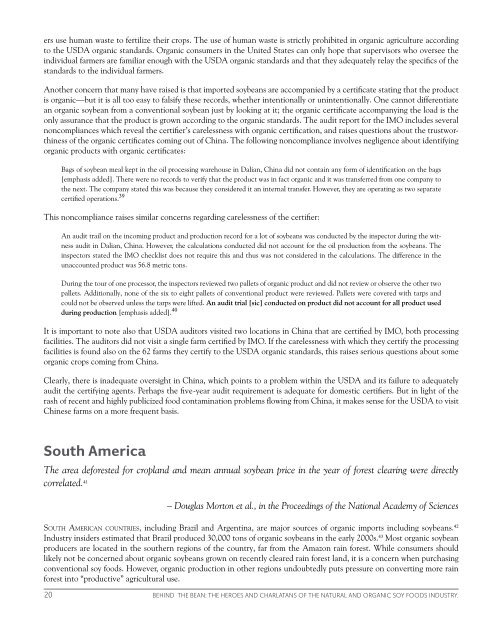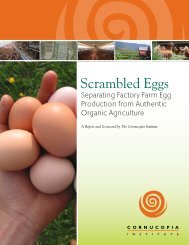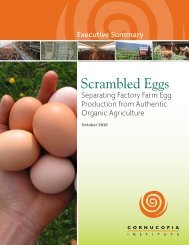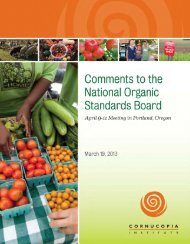“Behind the Bean” (pdf) - Cornucopia Institute
“Behind the Bean” (pdf) - Cornucopia Institute
“Behind the Bean” (pdf) - Cornucopia Institute
Create successful ePaper yourself
Turn your PDF publications into a flip-book with our unique Google optimized e-Paper software.
ers use human waste to fertilize <strong>the</strong>ir crops. The use of human waste is strictly prohibited in organic agriculture according<br />
to <strong>the</strong> USDA organic standards. Organic consumers in <strong>the</strong> United States can only hope that supervisors who oversee <strong>the</strong><br />
individual farmers are familiar enough with <strong>the</strong> USDA organic standards and that <strong>the</strong>y adequately relay <strong>the</strong> specifics of <strong>the</strong><br />
standards to <strong>the</strong> individual farmers.<br />
Ano<strong>the</strong>r concern that many have raised is that imported soybeans are accompanied by a certificate stating that <strong>the</strong> product<br />
is organic—but it is all too easy to falsify <strong>the</strong>se records, whe<strong>the</strong>r intentionally or unintentionally. One cannot differentiate<br />
an organic soybean from a conventional soybean just by looking at it; <strong>the</strong> organic certificate accompanying <strong>the</strong> load is <strong>the</strong><br />
only assurance that <strong>the</strong> product is grown according to <strong>the</strong> organic standards. The audit report for <strong>the</strong> IMO includes several<br />
noncompliances which reveal <strong>the</strong> certifier’s carelessness with organic certification, and raises questions about <strong>the</strong> trustworthiness<br />
of <strong>the</strong> organic certificates coming out of China. The following noncompliance involves negligence about identifying<br />
organic products with organic certificates:<br />
Bags of soybean meal kept in <strong>the</strong> oil processing warehouse in Dalian, China did not contain any form of identification on <strong>the</strong> bags<br />
[emphasis added]. There were no records to verify that <strong>the</strong> product was in fact organic and it was transferred from one company to<br />
<strong>the</strong> next. The company stated this was because <strong>the</strong>y considered it an internal transfer. However, <strong>the</strong>y are operating as two separate<br />
certified operations. 39<br />
This noncompliance raises similar concerns regarding carelessness of <strong>the</strong> certifier:<br />
An audit trail on <strong>the</strong> incoming product and production record for a lot of soybeans was conducted by <strong>the</strong> inspector during <strong>the</strong> witness<br />
audit in Dalian, China. However, <strong>the</strong> calculations conducted did not account for <strong>the</strong> oil production from <strong>the</strong> soybeans. The<br />
inspectors stated <strong>the</strong> IMO checklist does not require this and thus was not considered in <strong>the</strong> calculations. The difference in <strong>the</strong><br />
unaccounted product was 56.8 metric tons.<br />
During <strong>the</strong> tour of one processor, <strong>the</strong> inspectors reviewed two pallets of organic product and did not review or observe <strong>the</strong> o<strong>the</strong>r two<br />
pallets. Additionally, none of <strong>the</strong> six to eight pallets of conventional product were reviewed. Pallets were covered with tarps and<br />
could not be observed unless <strong>the</strong> tarps were lifted. An audit trial [sic] conducted on product did not account for all product used<br />
during production [emphasis added]. 40<br />
It is important to note also that USDA auditors visited two locations in China that are certified by IMO, both processing<br />
facilities. The auditors did not visit a single farm certified by IMO. If <strong>the</strong> carelessness with which <strong>the</strong>y certify <strong>the</strong> processing<br />
facilities is found also on <strong>the</strong> 62 farms <strong>the</strong>y certify to <strong>the</strong> USDA organic standards, this raises serious questions about some<br />
organic crops coming from China.<br />
Clearly, <strong>the</strong>re is inadequate oversight in China, which points to a problem within <strong>the</strong> USDA and its failure to adequately<br />
audit <strong>the</strong> certifying agents. Perhaps <strong>the</strong> five-year audit requirement is adequate for domestic certifiers. But in light of <strong>the</strong><br />
rash of recent and highly publicized food contamination problems flowing from China, it makes sense for <strong>the</strong> USDA to visit<br />
Chinese farms on a more frequent basis.<br />
South America<br />
The area deforested for cropland and mean annual soybean price in <strong>the</strong> year of forest clearing were directly<br />
correlated. 41<br />
– Douglas Morton et al., in <strong>the</strong> Proceedings of <strong>the</strong> National Academy of Sciences<br />
So u t h Am e r i c a n c o u n t r i e s, including Brazil and Argentina, are major sources of organic imports including soybeans. 42<br />
Industry insiders estimated that Brazil produced 30,000 tons of organic soybeans in <strong>the</strong> early 2000s. 43 Most organic soybean<br />
producers are located in <strong>the</strong> sou<strong>the</strong>rn regions of <strong>the</strong> country, far from <strong>the</strong> Amazon rain forest. While consumers should<br />
likely not be concerned about organic soybeans grown on recently cleared rain forest land, it is a concern when purchasing<br />
conventional soy foods. However, organic production in o<strong>the</strong>r regions undoubtedly puts pressure on converting more rain<br />
forest into “productive” agricultural use.<br />
20 Behind <strong>the</strong> bean: The Heroes and Charlatans of <strong>the</strong> Natural and Organic Soy Foods Industry.





